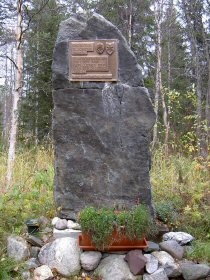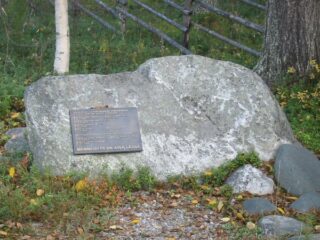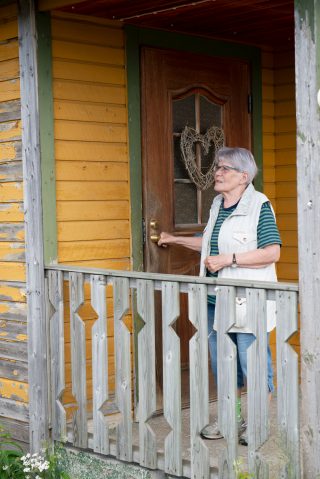The Salpa Line
The Lahtela fortress along Lämsänkyläntie is an impressive and open tourist destination and a monument to the Salpa Line. The area’s trenches, firing pits and part of the armour barrier have been restored according to the original fortress drawings.
The eastern defence line from the Gulf of Finland to Salla was mainly built in 1940–1941 and 1944. In the case of Kuusamo, the purpose was to protect the church village from the east by building strong armoured and other barriers on the isthmus between the largest lakes. In the fall of 1944, retreating Russian soldiers blew up the huge bunkers and took everything usable with them.
Read more about the Salpa Line fortress route

The memorial to the fallen German soldiers in the direction of Kiestinki.
Lue lisää muistomerkistä: Etelä-Kuusamon muistomerkit -sivuilta
Blacksmith’s workshop in Mustaniemi
The blacksmith’s workshop, which has been restored to use, is an impressive place to visit for those interested. The workshop is not open to the public, but visits can be arranged (contact Helena Palosaari, email: helena.palosaari@gmail.com)
Originally built on the shore of Lake Kuusamojärvi in the old Mustaniemi around 1870–1880, the workshop was moved to its current location before the Winter War in 1939 next to the road Lämsänkyläntie. In the fall of 1944, it was moved by the Russians to Toranginaho as a residence. In the spring of 1945, when people returned from the evacuation, the workshop was found, and it was returned to its former location by the side of Lämsänkyläntie.
In the blacksmith’s workshop, scythes, sickles, axes, knives, drills, iron bars, ploughs, spikes, hooks, anchors, cartwheels, hinges, hook locks, cowbells and bell tongues, link collars, horseshoes and shoe nails, keys, oven hatches, etc. were forged in the blacksmith’s workshop. However, since 1976, there has been no sound of a hammer from Mustaniemi.

Memorial to the victims of the partisans
A memorial to the victims of the partisans has been erected on the site of Uusitalo. On July 18th, 1943, partisans attacked Multiperä’s Uusitalo in Lämsänkylä and killed six people: the mother, the grandmother, the grandfather, the aunt and two children. They took with them the father Ville, who had come on a haymaking leave from the Karelian Isthmus troops, and two cows. In the summer of 1942, the partisans took the Tammela brothers Lassi and Kalle, who were making hay, with them.
There is now a memorial to the partisan victims at the site of Uusitalo.
The Lämsä treasure – Kuusamo’s axe
Lämsänkylä’s silver treasure was discovered by Arvo Määttä in 1953. At that time, the village road of Multiperä or Tauriainen was being built. On October 5th, 1953, road work had progressed to the isthmus between the lakes Joukamojärvi and Kuurnajärvi at the eastern end of Hautalampi. A small sand mound was being cut when Arvo Määttä’s shovel hit a metal object. When he started to examine the object, he found it to be a silver necklace, under which he found four more silver necklaces with a diameter of 15–17 cm. About half a meter away was another cache with two bracelets and three silver buckles. Both caches were wrapped in birch tree bark.
Where the treasure was found is not an attention-grabbing terrain, but in its immediate vicinity there are a couple of old Sámi settlements, a “deserted house” and deer pits. A little further south, around Välijärvi and Multikoski, there are more Sámi settlements. In addition, there are mounds on the south bank of Multikoski, the purpose of which is unknown. Based on the decoration and method of making the objects and signs of habitation thus preserved in nature, the treasure has been dated between 1050 and 1150.
From the silver treasure of Lämsänkylä to the axe of Kuusamo
In 1953, Arvo Määttä, who was doing shovel work on a road construction site, found a treasure at the eastern end of Hautalampi: a silver axe pendant, four necklaces, two bracelets and three horseshoe buckles. The objects likely made in Karelia date to the period 1050–1150.
At the initiative of the people of Kuusamo, Lämsä’s pendant became Kuusamo’s axe, one of Kalevala Koru jewellery’s best-selling pieces.
The Lämsänkylä treasure find is on display in the prehistoric section of the National Museum in Helsinki.
